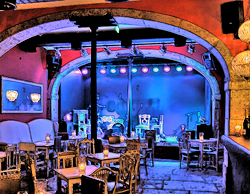
Loudspeaker Issues
Loudspeaker selection and placement is, singularly, the most distinctive feature of any given sound system.
The two most popular styles are combinations of horn-loaded direct radiators and compression drivers and line arrays of direct radiator cone loudspeakers.
If one has decided to go the horn route, it is very important to remember the facts of life concerning horns: Any horn’s capability to deliver clean sound at rated power levels decreases at least 18 dB per octave below the manufacturer’s recommended crossover frequency.
Horn choice should be limited to those made from composite materials, such as combinations of fiberglass and plastic, fiberglass and plywood, or non-homogeneous fiberglass.
Generally, horns should not be boxed, although this is sometimes done to facilitate carrying and stacking. However, if horns must be boxed, it is advisable to fill the box with foam or fiberglass to prevent any sound which leaks through the back of the horn from reflecting around the inside of the box causing extraneous noise and distortion.
Dense foam or fiberglass will also protect the horns from breaking loose if a box is accidentally dropped. If the horn is to stand free, it is good practice to coat the rear facing surfaces with auto undercoat, carpet, or even machinery rubber. This will reduce rear sound radiation as well as adding mass to the horn material.
Mass will reduce the tendency for the horn to ring. It will also help to reduce the tendency of the horn material to propagate a wavefront faster than air in the horn, which can cause a position smear in the output of the horn, and non-linear frequency response. Speed of sound in aluminum is 10 times the speed of sound in free air.
Always attempt to keep all the driver elements covering a given sector in close proximity to one another. The higher the frequency range, the closer they should be kept together. This same point is valid for HF direct-radiator arrays. Both systems have equal difficulty in achieving the desired effect, and compromises in distortion are involved with either system.
The difference in direct-radiator and hom-loaded sound lies in the spectral distributions of the distortion products. In other words, everything has some distortion, but the frequencies involved may vary. Choice of loudspeakers then becomes a matter of personal taste, at least partially. Some people prefer the “punch” they get with horns. Others feel that horns have a lot of distortion, and they prefer
the “soft” sound a cone produces.
Practically speaking the difference in cost, size, weight, and efficiency, as well as maintenance, must be weighed against the requirements of the specific application. A permanent installation has it all over the road system in this category.
House loudspeakers are usually located on both sides of the stage anywhere from floor to ceiling. Ideally, such units should be kept well off the floor for two reasons: One, people get in the way, and: Two, the previously described problem of distributing the sound equally to the front and the rear seats. This is particularly true when/if units are too close to the audience in front; so that a vastly different tonal balance exists in that area.
Sometimes the loudspeaker system can be divided into short throw sectors, each radiating primarily into its own section of the audience. Projecting the highs to the rear is relatively easy.
Throwing high bass (400-800 Hz) to the rear, especially in a club where the floor slopes up sharply, as in theatre clubs, requires a horn that is angled upward. Accurate and carefully placed sound is very critical if there is a dance floor over which the performers must relate well to their audience.
If a horn system is to be considered here, it should have an acoustic lens for the near-stage area so that the edges of the horn pattern fall off gradually (Editor’s Note: The Acoustic Lens design has, for the most part, fallen from favor for this and most other Performance Audio functions.)
